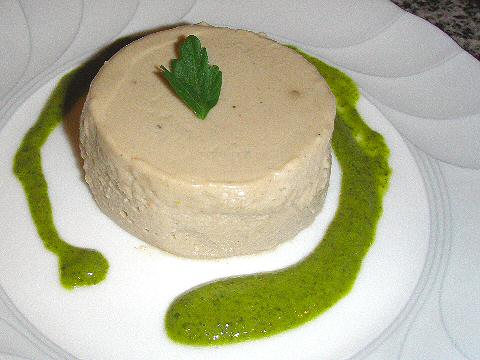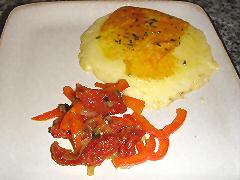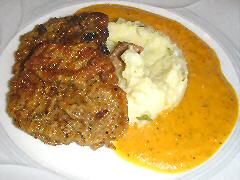“[Cooking] is spontaneous. It’s what hits you at the moment, not the result of years of carefully crafting details. It doesn’t follow a strict formula, though you might notice similarities and consistencies of style. All the rules are open to reinterpretation.
– paraphrase from Chip Camden, software developer
Buenos Aires – With strains of the music from the original Broadway cast of Don’t Cry for me Argentina running through my head, I sat trying to figure out just what it was I was going to prepare. A private party, the host having held his birthday party here back in March with a re-working of Colombian cuisine, he wanted the same treatment for his guests with Argentine dishes. His invitados included a group of norteamericanos down here for their first visit, one which he apparently organized for them, as well as several local porteño friends. How was I going to make both of them happy? The former were out to get a taste of Argentina, with some twists that wouldn’t be what they’d be experiencing at every local parrilla over the next week or so, and the latter were no doubt casting an eye, and fork, upon my plates with a comparison to exactly those same places. Paraphrasing Oldsmobile, I told them upfront, “This is not your mom’s home cooking…”

I wanted to hit some ideas from various parts of the country, not just local parrilla food – plus, the weather is not such that I can quite fire up the grill. Actually, we haven’t tried using the grill yet for a Casa SaltShaker dinner, and I’m not sure if we will in the future – it being in the back garden, at the opposite end of the apartment from the kitchen where everything else would be being prepared. We shall see. One of the things I see regularly are mushroom dishes from Patagonia in particular. While mushrooms are certainly available locally, they seem to be used for little other than perhaps a simple sauce for a steak, and that’s not even particularly common. I went back and forth with several ideas – and for awhile I’d settled on some mixed mushroom empanadas – and a separate dish of homemade chicken chorizos… but in the end, I decided I needed one cold dish, which was not going to be the chorizos, and the idea of a mushroom mousse came to mind – just a month ago people were raving about the leek and smoked trout mousse at our Bastille Day dinner.
So, easily the night’s most radical of reinterpretation of anything I’ve ever seen locally, but hopefully staying true to some of the local flavors… a mushroom mousse. In 75 grams (1/3 cup) of butter, saute two chopped onions until soft. Add 650 grams (a pound and a half) of sliced mushrooms (I used a mix of white button and small portobellos) and cook down until the liquid has pretty much evaporated and the mushrooms are starting to caramelize. Put them in the blender with 650 grams (2¾ cups) of milk and the rind of one lemon, and blend until completely smooth. Place 20 grams (this one you’ll have to weigh out, it’s a little under an ounce) of gelatin in 5 tablespoons of cold water and mix, then heat until completely dissolved, add to the blender along with 250 milliliters of heavy cream (basically a cup), and season to taste with salt, black pepper and nutmeg. That’s a judgment call, I probably used a tablespoon of salt, a teaspoon of pepper, and half a teaspoon of nutmeg. Keep in mind, that you’re tasting this warm, and as the mousse chills and sets, the flavors will be muted, so slightly over-season. Pour into buttered ramekins and stick them in the refrigerator to set. When ready to serve, dip them in hot water for 5 seconds, run a knife around the inside, and gently shake out onto a plate. Surround with a sauce made from a large quantity of parsley (including the upper parts of the stems, just to make it easier) pureed with lemon juice and good olive oil, and just enough salt to balance the sharpness of the lemon.
 I knew I wanted to offer up a provoleta of sorts, that wonderful, gooey, grilled slice of cheese that is a heart attack on a plate, but oh so good. To fancy it up a bit I went with a provoleta rellena, or stuffed version, though serving the stuffing on the side, and I decided to use one of my favorite local cheeses, fynbo, which also, conveniently, I found in small wheels, making it easy to come up with a smaller than normal provoleta (a whole one is a lot of food, especially in a tasting menu). I sliced the wheels into discs about ½” thick, and let them sit out on wire racks to develop a little bit of an air dried crust. I also pressed some pimentón amarillo, dried parsley and oregano into the surface. When ready to cook, I simply lightly oiled a cast iron griddle and cooked them until brown on top and bottom and all melty in the middle. For the “rellena”, I sauteed julienned onions in olive oil, then added slivers of red bell pepper, when they were both cooked I tossed in strips of reconstituted sun dried tomatoes, and some finely chopped rocoto pepper and black olives. I served that on the side of the “provoletas”, giving the dish just a little picante touch.
I knew I wanted to offer up a provoleta of sorts, that wonderful, gooey, grilled slice of cheese that is a heart attack on a plate, but oh so good. To fancy it up a bit I went with a provoleta rellena, or stuffed version, though serving the stuffing on the side, and I decided to use one of my favorite local cheeses, fynbo, which also, conveniently, I found in small wheels, making it easy to come up with a smaller than normal provoleta (a whole one is a lot of food, especially in a tasting menu). I sliced the wheels into discs about ½” thick, and let them sit out on wire racks to develop a little bit of an air dried crust. I also pressed some pimentón amarillo, dried parsley and oregano into the surface. When ready to cook, I simply lightly oiled a cast iron griddle and cooked them until brown on top and bottom and all melty in the middle. For the “rellena”, I sauteed julienned onions in olive oil, then added slivers of red bell pepper, when they were both cooked I tossed in strips of reconstituted sun dried tomatoes, and some finely chopped rocoto pepper and black olives. I served that on the side of the “provoletas”, giving the dish just a little picante touch.
I had really wanted to make my own chorizos for the evening, with my own twists on spicing, but the one catch, I’d been told “no pork”, so I went with finely chopped chicken, cooked down with lots of garlic, green onions, and smoked paprika, and a bit of cloves, nutmeg, white pepper, and salt, and then finished it with some red wine cooked just until it absorbed into the meat. I let the chicken cool off to the side and then filled empanada skins with the mixture, and baked them to order. To serve, a homemade chimichurri, a local favorite sauce of which there are as many versions as there are cooks here – in this case I went with a more pureed version than I usually do because I wanted it to be dip-able… I threw into the blender (it was getting a workout) a tomato, a red bell pepper, a rocoto pepper, garlic, parsley, and a little dried oregano, a little each of white wine and white wine vinegar, and just enough olive oil to puree it up to a thick sauce.
 Now, the last two courses were based on requests from the host, he had told me that milanesas of some sort were his favorite – and, by sheer luck, a local butcher had made a stack of beautiful small milanesas from peceto, or top round, which are nice discs about 2½” across. I dipped them in flour, then in an egg and milk wash, and then into a finely ground mixture of breadcrumbs, nori seaweed, and bonito flakes – thank you to Patricia Yeo for that one, makes a great crust on veal – and then simply fried them off in a little olive oil and butter, keeping a platter of them hot in the oven until ready to serve. I leaned two of them up against a nice cylinder of mashed potato and zucchini (about 3:1 on the potatoes to the zucchini and just simply mash together), simply finished with butter, milk, salt, and pepper. And spooned a bit of my favorite roasted tomato wine sauce around the plate (two tomatoes, one onion, a couple cloves of garlic roasted until nearly blackened, along with parsley, oregano, and basil, all pureed together with some reduced wine).
Now, the last two courses were based on requests from the host, he had told me that milanesas of some sort were his favorite – and, by sheer luck, a local butcher had made a stack of beautiful small milanesas from peceto, or top round, which are nice discs about 2½” across. I dipped them in flour, then in an egg and milk wash, and then into a finely ground mixture of breadcrumbs, nori seaweed, and bonito flakes – thank you to Patricia Yeo for that one, makes a great crust on veal – and then simply fried them off in a little olive oil and butter, keeping a platter of them hot in the oven until ready to serve. I leaned two of them up against a nice cylinder of mashed potato and zucchini (about 3:1 on the potatoes to the zucchini and just simply mash together), simply finished with butter, milk, salt, and pepper. And spooned a bit of my favorite roasted tomato wine sauce around the plate (two tomatoes, one onion, a couple cloves of garlic roasted until nearly blackened, along with parsley, oregano, and basil, all pureed together with some reduced wine).
The dessert, a dulce de leche cheesecake, my standard secret cheesecake recipe with a cup of dulce de leche standing in for a cup of the sugar, and topping the whole thing with whipped cream and shaved dark chocolate infused with orange peel. The host’s only comment, “sinful” – dulce de leche having been a “must have” both for himself and for introducing his guests to the stuff.
Overall, a success, without going too far off the map of Argentina’s culinary range, but still making it our own Casa S style.
From the host:
[…] Perlman took part of my Jazz writing post and reapplied it to cooking. Now that’s what jazz is all […]
[…] Perlman took part of my Jazz writing post and reapplied it to cooking. Now that’s what jazz is all […]
Not only does the dinner sound superb, but you apparently pleased the one guest who may have mattered the most. This is great.